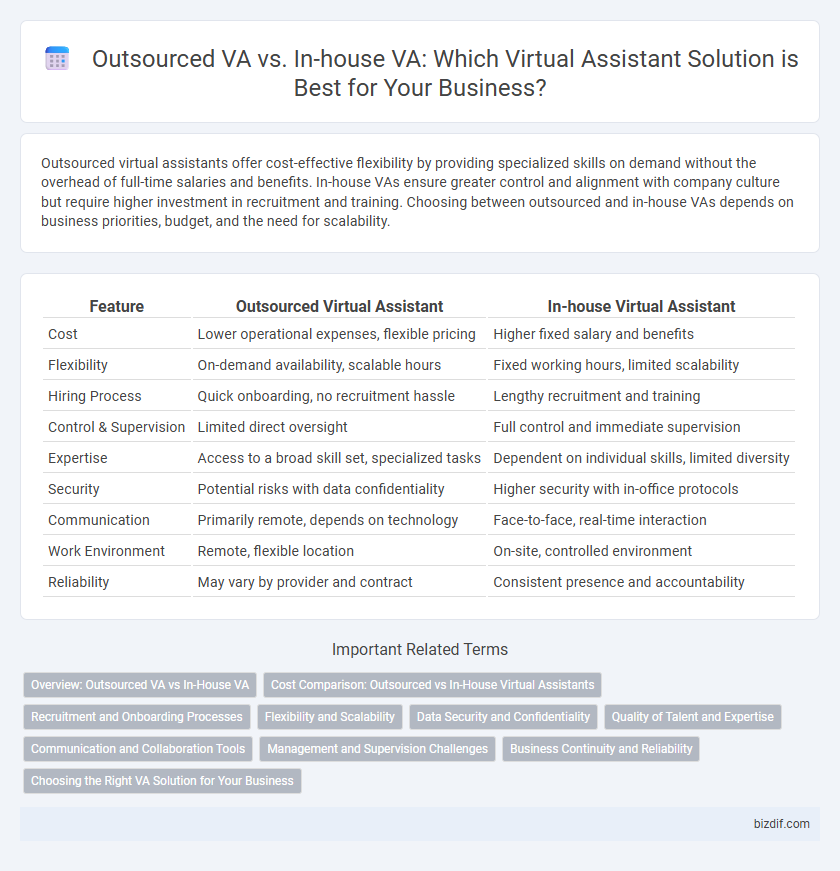Outsourced virtual assistants offer cost-effective flexibility by providing specialized skills on demand without the overhead of full-time salaries and benefits. In-house VAs ensure greater control and alignment with company culture but require higher investment in recruitment and training. Choosing between outsourced and in-house VAs depends on business priorities, budget, and the need for scalability.
Table of Comparison
| Feature | Outsourced Virtual Assistant | In-house Virtual Assistant |
|---|---|---|
| Cost | Lower operational expenses, flexible pricing | Higher fixed salary and benefits |
| Flexibility | On-demand availability, scalable hours | Fixed working hours, limited scalability |
| Hiring Process | Quick onboarding, no recruitment hassle | Lengthy recruitment and training |
| Control & Supervision | Limited direct oversight | Full control and immediate supervision |
| Expertise | Access to a broad skill set, specialized tasks | Dependent on individual skills, limited diversity |
| Security | Potential risks with data confidentiality | Higher security with in-office protocols |
| Communication | Primarily remote, depends on technology | Face-to-face, real-time interaction |
| Work Environment | Remote, flexible location | On-site, controlled environment |
| Reliability | May vary by provider and contract | Consistent presence and accountability |
Overview: Outsourced VA vs In-House VA
Outsourced virtual assistants offer cost-effective scalability and access to specialized skills without the need for physical office space, making them ideal for dynamic workloads and remote collaboration. In-house virtual assistants provide greater control, immediate communication, and seamless integration with existing teams but incur higher costs due to salaries, benefits, and office resources. Organizations must evaluate budget constraints, operational flexibility, and desired oversight to determine whether outsourced or in-house virtual assistance aligns best with their business goals.
Cost Comparison: Outsourced vs In-House Virtual Assistants
Outsourced virtual assistants typically reduce operational costs by eliminating expenses related to office space, equipment, and employee benefits, offering flexible hourly or project-based rates. In-house VAs require a fixed salary, payroll taxes, and additional overhead, which can significantly increase the total cost of employment. Businesses prioritizing budget efficiency often prefer outsourced VAs for scalable, cost-effective support tailored to fluctuating workload demands.
Recruitment and Onboarding Processes
Outsourced virtual assistants streamline recruitment by leveraging specialized agencies that provide pre-vetted candidates, reducing hiring time and costs, while in-house virtual assistants require extensive internal recruitment efforts involving job postings, interviews, and background checks. Onboarding outsourced VAs typically involves brief orientation focused on project-specific tools and communication protocols, whereas in-house hires undergo comprehensive onboarding including company culture immersion, training, and integration with internal teams. The scalability and flexibility of outsourced VA recruitment and onboarding processes offer businesses faster access to skilled professionals compared to the more resource-intensive in-house approach.
Flexibility and Scalability
Outsourced virtual assistants offer greater flexibility by allowing businesses to scale their support needs up or down quickly without the constraints of fixed office hours or physical space. In-house VAs may require more rigid scheduling and additional resources, limiting rapid expansion or contraction. Leveraging outsourced VAs enables companies to efficiently manage workload fluctuations and optimize operational costs.
Data Security and Confidentiality
Outsourced virtual assistants often rely on secure cloud platforms with encrypted communication channels to protect sensitive data, yet they may pose higher risks due to third-party access and varying compliance standards. In-house virtual assistants provide greater control over data security protocols and confidentiality measures, minimizing exposure to external breaches through direct oversight and dedicated IT infrastructure. Companies must evaluate their data protection policies, regulatory requirements, and risk tolerance to choose the appropriate VA model for safeguarding sensitive information.
Quality of Talent and Expertise
Outsourced virtual assistants often provide access to a diverse pool of specialized talent with global expertise, enabling businesses to find highly skilled professionals tailored to specific needs. In-house virtual assistants typically offer closer alignment with company culture and direct oversight, but may have limited exposure to varied industries or cutting-edge practices. Evaluating quality of talent involves balancing the depth of specialized skills from outsourced experts against the personalized engagement and consistency of in-house teams.
Communication and Collaboration Tools
Outsourced virtual assistants often rely on advanced communication and collaboration tools such as Slack, Zoom, and Trello to maintain seamless interactions across different time zones, enhancing workflow efficiency. In-house virtual assistants benefit from direct face-to-face communication and instant access to internal systems, fostering real-time collaboration without relying heavily on digital platforms. Choosing between outsourced and in-house VAs depends on the organization's preference for flexibility and the necessity of immediate, personal interaction within the team environment.
Management and Supervision Challenges
Outsourced virtual assistants often require robust digital communication tools and clear protocols to navigate time zone differences and ensure task alignment, posing management and supervision challenges. In-house virtual assistants allow for more direct oversight and instant feedback but can increase operational costs and demand dedicated supervisory resources. Balancing these factors depends on a company's ability to implement efficient management systems tailored to remote or on-premise workflows.
Business Continuity and Reliability
Outsourced virtual assistants offer enhanced business continuity through diversified talent pools and scalable support, reducing risks associated with employee turnover and unexpected absences. In-house virtual assistants provide greater control and direct oversight, ensuring alignment with company culture and immediate availability. Reliability in outsourced VAs is strengthened by contractual service level agreements, while in-house VAs rely on internal management systems to maintain consistent performance.
Choosing the Right VA Solution for Your Business
Outsourced virtual assistants provide cost-effective flexibility and access to specialized skills without long-term commitments, making them ideal for startups and businesses with fluctuating workloads. In-house virtual assistants offer greater control, direct supervision, and seamless integration with company culture, benefiting organizations requiring consistent, hands-on support. Assess business needs, budget constraints, and desired management style to determine the most suitable VA solution for maximizing productivity and operational efficiency.
Outsourced VA vs In-house VA Infographic

 bizdif.com
bizdif.com